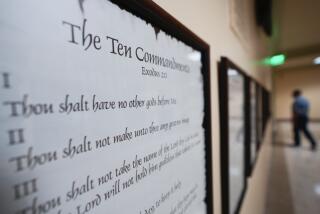Mormons Modify Temple Rites : Ceremony: Woman’s vow to obey husband is dropped. Changes are called most significant since 1978.
- Share via
The central temple ceremony in the Mormon Church has been changed to eliminate the woman’s vow to obey her husband and other elements that some members said were offensive and outdated.
In the new version of the rites, women now pledge to obey God and to merely listen to the advice of their husbands.
“That’s the most significant change in the church since blacks received the priesthood in 1978,” said Ron Priddis, vice president of Signature Books in Salt Lake City, an independent publisher of Mormon-oriented books. “In a church that is so patriarchal, that’s quite a step.”
Two other features dropped were a dramatization suggesting that Satan beguiles Christian clergy to teach false doctrine and the requirement that members make throat-slitting and disemboweling gestures as signs that they will not reveal the ceremony’s contents.
Despite verbal oaths of secrecy that remain in effect, a consistent picture of the changes introduced last month has emerged from interviews with both Mormons and non-Mormons who monitor church activities.
The new version “reflects greater sensitivity and awareness of women and women’s role in the Christian church,” said Robert Rees, a Mormon bishop who also directs the fine arts program for UCLA’s extension department. Although unwilling to disclose elements of the ritual, Rees nevertheless said that some parts eliminated “were historical and cultural anachronisms.”
Lavina Fielding Anderson of Salt Lake City, editor-elect of the Journal of Mormon History, said she received the revisions “with joy.”
“I anticipate further changes with hope and faith,” she said in a telephone interview. “Some portions of the temple ceremony have been painful to some Mormon women and, in some respects, still are,” she added, without identifying what elements may still be objectionable.
Women, for example, still cover their faces with veils at certain points in the ritual, sources said.
Also dropped is an “embrace” of a man representing God, who stands behind a ceiling-to-floor veil. Reaching through a slit in the veil, the church member puts his or her hand to the back of the deity and presses against him at the cheek, shoulders, knees and feet with the veil between them. The contact at “five points of fellowship,” including the hand to his back, has been omitted, although the member must still give a secret handshake and repeat a lengthy password.
Spokesmen for the Church of Jesus Christ of Latter-day Saints, the formal name of the 7-million-member Mormon Church, have declined comment on the changes, saying the details of the rites are sacred and confidential.
“We are a church that believes in modern and continuous revelation, and the changes that were recently made in our temple ceremony are reflective of that process,” officials said in a statement this week.
One of the most common temple rites performed by members in good standing are proxy baptisms and weddings--in which members stand in for ancestors who are thus offered Mormon membership and privileges in the afterlife.
Objections to parts of the ceremony have been raised obliquely in Mormon intellectual circles in recent years. Mormon academics have said that the temple rites, rather than deriving purely from ancient religious sources, borrowed certain features from Masonic fraternal rites during the last century.
David John Buerger of the University of Santa Clara wrote in a 1987 issue of the independent Mormon journal Dialogue that, while many Mormons found the temple ceremonies entirely meaningful, some were disturbed by “the implied violence” of gestures of throat slitting, “the portrayal of a Christian minister as the hireling of Satan” and the depiction of women “as subservient to men.”
In pledging to never reveal the ritual, Mormons formerly made three motions--drawing one’s hand quickly across the throat, another indicating one’s heart would be cut out and the third suggesting disembowelment.
“That’s why I stopped going to the temple, because (the ritual) was so offensive,” said a former woman member in Salt Lake City.
The so-called penalty gestures were criticized as “outgrowing their usefulness” in a talk before a Mormon audience about a month ago by Keith Norman, a church member in the Cleveland area who holds a doctorate in Christian studies from Duke University. “I had no idea this change was about to take place,” Norman said after the modifications were introduced.
In recent weeks, anti-Mormon, evangelical Christian ministries have been spreading reports of the changes. Some candid Mormon officials have acknowledged in interviews that the whole secret ritual was published years ago by church critics Jerald and Sandra Tanner of Salt Lake City.
“I feel that dropping the wife’s oath of obedience to the husband was a concession to the women’s liberation movement,” said Sandra Tanner in a phone interview.
Ex-Mormons Chuck and Dolly Sackett of Thousand Oaks, who circulated a brochure detailing the changes, noted that single Mormon women also had been required to swear obedience to their husbands--despite the fact they were unmarried.
“Single women will be somewhat relieved of the extreme pressure to marry,” said the circular. “The wife will no longer be reminded with each temple visit that her only channel to her god is through her husband and that his faithfulness determines her eternity.”
More to Read
Sign up for Essential California
The most important California stories and recommendations in your inbox every morning.
You may occasionally receive promotional content from the Los Angeles Times.













